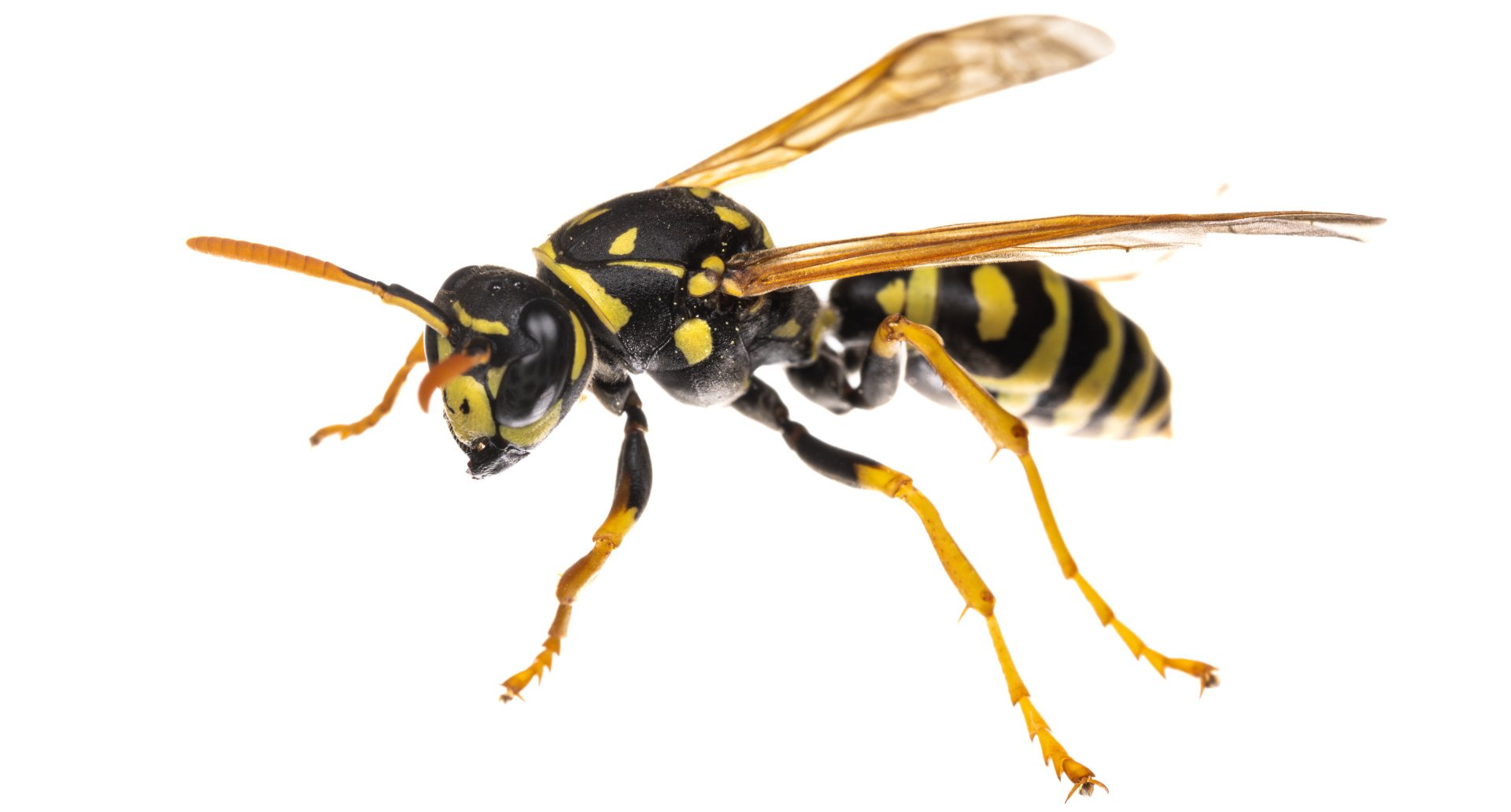Are Wasps Dangerous?

Wasps can be dangerous to humans because they are aggressive and territorial stinging insects. They defend themselves using their stingers like bees. An individual sting will cause an intense, sharp pain that wears off after 10 minutes. If there is an allergic reaction, medication or medical attention may be required. Wasps will also release a chemical pheromone that warn the other wasps of a threat to their nest, causing a swarm to attack. This is when wasp interactions can become deadly. Unlike bees, wasps can sting repeatedly so a swarmed attack can cause several hundreds of stings in a short time.
Problem With Wasps
The biggest problem with wasps is that certain species of wasps can be extremely aggressive and territorial. They are known to attack with little to no provocation. This is why wasp nests should be avoided and treated to minimize the potential of a wasp attack. Different wasp species will nest in different locations. Yellow jackets will create underground burrows while paper wasps will create hanging nests under rooftop eaves. No matter where the nest is, the wasps will guard their territory against perceived threats to ensure that their nest, food supply, and other resources are protected.
Difference Between Wasps and Bees
While wasps and bees share many similarities, wasps tend to be more aggressive and dangerous while providing less benefit as a pollinator. Wasps have a smooth stinger that they can use to sting a threat repeatedly while bees have a barbed stinger that is attached to the bee. Wasps’ stingers are like little syringes that can be retracted into their body and can be extended over and over again to strike their target. Bees sting only once because the barbed stinger gets stuck inside its target to release venom. The unfortunate reality for the bee is that this barbed stinger will get ripped out of their body when they try to take off which causes the bee to become disemboweled and die.
Why Are Wasps Dangerous to Humans?
Wasps can be dangerous to humans and are notorious for attacking without reason. They can target something passing by just for being inside the wasp’s territory. Wasps will release a pheromone to signal to the rest of the nest that there is a potential threat, which will cause a swarm to emerge to defend the colony. They also release this pheromone whenever they sting or when they are crushed which is why it isn’t recommended that you swat at a wasp when it approaches. A wasps’ nest on your property can have hundreds of wasps, and this could trigger a swarm of wasps to come attack. An attack from a swarm with even a few wasps can result in 30 – 40 stings which can have devastating, if not deadly, results.
Which Types of Wasps are Dangerous?
Wasps can primarily be categorized into solitary or social wasps due to how they interact with others within their own species.
Social wasps are the larger threat since they are capable of calling for reinforcements when threatened. These types include paper wasps and yellow jackets, and they tend to be aggressive. These wasps are all part of a larger colony, so they instinctually protect their nest and the eggs and larvae that the nests contain. If there is a perceived threat, they will swarm and repeatedly attack until the threat escapes or is neutralized.
Solitary wasps aren’t as much of a threat as social wasps. These wasps include mud daubers and fig wasps which are much more likely to keep to themselves unless threatened. They are not part of a larger group of wasps so there is no need to protect the colony. These wasps roam around individually so they are much more exposed to danger without the support of other wasps.
Wasp Stings
Wasp stings are typically painful, and a wasp attack will land several stings in a matter of seconds. Each sting will release a small amount of venom that causes prolonged pain after the initial attack. When measured on the Schmidt pain index, wasps typically deliver a sting that will result in a 2 or 3 on a range of 0 to 4. This pain lasts anywhere from 5-10 minutes while your body processes the trauma and venom that was injected into the skin. The venom will result in a sharp burning sensation after the initial pain from the sting which will subside into a dull throbbing after some time.
Do Wasps Sting for No Reason
Certain species of wasps can be extremely aggressive and have been known to attack unprovoked. Other species are more docile and will mostly ignore you if you don’t give them a reason to bother you. Typically, the primary reasons for wasps to sting an individual usually fall into one of 4 reasons:
- Wasps will protect their nest against a perceived threat. Social wasps are extremely territorial and will act aggressively towards anything that comes too close to their nest. They will often attack with little to no provocation.
- In fall, resources available to wasps decline which causes wasps to become hungrier and more aggressive in their search for food. As the seasons change, wasp behavior changes and the colony will start to die off while any remaining wasps will defend available food resources to survive as long as possible. If you happen to disturb a wasp at this point in their lifecycle, they will act aggressive towards you to protect their food.
- Wasps are capable of releasing pheromones that will trigger other wasps to come and act aggressively. This happens when a wasp uses their stinger or when a wasp is crushed. Both instances indicate to wasps that there is a threat nearby which calls in reinforcements.
- Wasps are curious and will find their way into places where they find themselves trapped. They may come inside open doors and windows and find themselves inside open containers of food or shoes. When a wasp feels trapped, they will act aggressively to free themselves.
What to Do When Wasps Attack
When you find yourself around a wasp, the best thing to do is nothing. Do not wave your hands around to brush it away and more importantly do not swat at it. If you happen to crush a wasp, they will release a pheromone that will attract other wasps to come defend against a threat. When wasps attack or swarm, do not remain still and do not seek shelter in water. It is important to run and try and remove yourself from danger by seeking shelter somewhere where you can prevent wasps from stinging you. Individually, a wasp sting is nothing more than a nuisance, but getting stung multiple times can be deadly.
Wasp Sting Treatment
If you receive a wasp sting, the stinger does not need to be removed like a bee’s stinger unless it is visibly stuck. The wasp stinger is smooth so it should still be attached to the wasp. It is important that the injury is cleaned with soap and water, and it is recommended that a cold compress is applied to the skin for 10 minutes to minimize swelling and inflammation. After 10 minutes, your body should be able to process the injury and most of the effects of the sting should fade. The injury site may be sore for several days, but the initial swelling and intense pain should decline quickly.
When To Seek Medical Attention
Signals that indicate it is time to seek medical attention include:
- If the site where you were stung does not improve after several days
- You have received the sting in or around your eyes or mouth
- If the site of the sting results in an extremely large welt bigger than 5 inches wide
- The injury site results in an infection, pus, or increasing swelling or pain
- A sting followed by fever, swollen lymph nodes, or flu like symptoms like nausea or vomiting
- A sting that results in signs of an allergic reaction like difficulty breathing or swallowing and swollen face, mouth, or throat
- Increased heart rate
- Dizziness, feeling faint, or loss of consciousness
When It Becomes a Medical Emergency Due to Allergic Reaction
Each sting delivers a small dose of venom which can cause reactions from red welts to anaphylactic shock due to an allergic reaction. Even without an allergic reaction, if an individual has been stung several times by a swarm of wasps, it can lead to complications that could pose a serious health risk. That said, it is critical that when allergic reactions happen, that an individual is treated with epinephrine. In cases of a minor allergic reaction, the use of antihistamines may be enough to prevent a serious reaction but anything severe may require medical assistance if the right medication is not readily available. Individuals that are severely allergic to wasp venom should carry 2 doses of an EpiPen just in case they are stung.
How to Prevent Wasp Stings
Preventing wasp stings can be tough since they tend to be more aggressive against threats but there are a few things that you can do to prevent wasps from being attracted to you.
- Avoid strong, sugary, or sweet-smelling fragrances and soaps
- Avoid wearing bright colors and floral patterns
- Stay away from orchards and fruiting trees
- Properly seal food and drinks
- Ensure that your face and body are not covered in food
If wasps are attracted to your space, do not panic. It is important that they are not threatened or annoyed with your actions so trying to swat or wave the wasps away may cause them to become aggressive.
Getting Rid of Wasps
Getting rid of wasps can be dangerous without knowing how to repel and prevent wasps properly. This is why it is so critical that professionals are enlisted to help support any wasp removal efforts. The team at EcoGuard Pest Management has years of experience providing wasp control and treating wasp nests, so call today to schedule an initial inspection. Once we have determined where the wasp nest is, we can safely treat and remove any wasp nests that may be on your property.

















